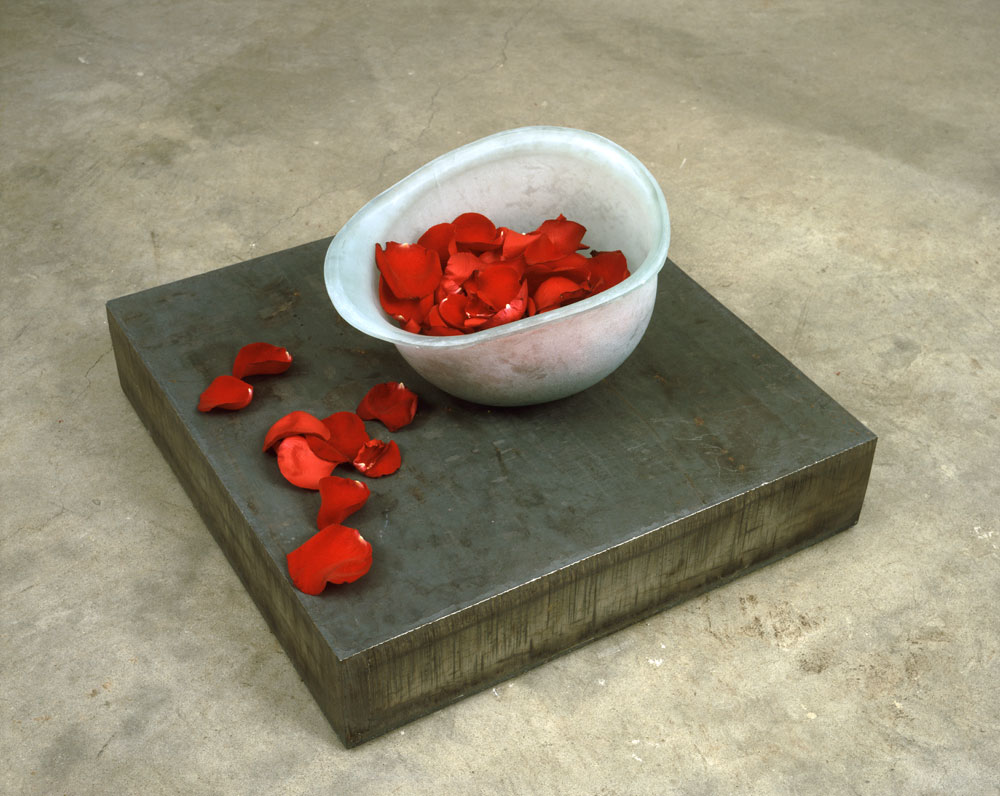
Growing up with Minimalism
July 29, 2015 · by John Haber
I remember Mammy. I wish I remembered Joseph Zito some other way, but this work has a way of getting under one’s skin.
Three cookie jars, in a form still recognizable from the likes of Aunt Jemima, hang like a single chain from the hand of a strikingly white lawn jockey. Willie Cole has since brought that icon up to date, as an African divine messenger, but Zito’s has never left planet earth. Rest assured that he has cast those jars in bronze, and, his gallery swears, they “yield a lovely bell-tone when struck with a wooden mallet.” I can hardly wait.
 'Untitled (Helmet)', Steel, Cast Glass & Rose Petals, 2005
'Untitled (Helmet)', Steel, Cast Glass & Rose Petals, 2005
In fact, Joseph Zito has been getting under one’s skin for some time now, while revitalizing Minimalism, in what a show calls “The First Thirty Years.” The very title has the phony ring of birthday reassurances to the elderly, although the artist is still in his fifties, with room to grow. He also chooses his targets carefully, at Lennon, Weinberg through September 26, based on what gets under his skin. Zito grew up as an Italian American in the racial mix of Brooklyn, where he still lives and works, and he hit upon Mammy while nursing his outrage at the racism disguised as scholarship of The Bell Curve. A seeming abstraction of five rectangles from 1992, My Weight in Lead, is just as impersonal and just as close to home. They, too descend from a single point on the wall, connected by steel wire that trails off unnervingly close to the floor.
Does Mammy hurt so much because it appeared in 1996, between the all-absorbing irony of, say, Richard Prince and the greater cynicism of Jeff Koons? It came between two distinct bodies of work for Zito as well, neither one much concerned for popular appeal and neither one simply appropriation. Taken together, they challenge one to make connections. They begin in 1985, with First Cut, maybe because the first cut is still the deepest. It consists of a single slit in the wall, barely three inches wide and eighteen inches tall, lined with steel. Yet things really get going in the early 1990s, in what became his first show with his present dealer, then in Soho.
The rusted steel and lead share their edge and materials with Richard Serra—but also their intimacy with Richard Tuttle, their care with Martin Puryear, their deliberate clumsiness with Joel Shapiro, their semblance of household furniture with Robert Gober or Doris Salcedo, and their body imagery with Post-Minimalists like Eva Hesse. Seven spikes rise from the floor, leaving one to decide between focusing on the danger of their points or the regularity of their tilted rows. The bottom few inches of each spike has lost its sheen, connecting them by an imagined polyhedron in brown. Two weathered copper disks, bound together, could be primitive armor, lethal weapons, or a body coming apart. In each case, though, imagery is at most implicit, and metaphor is out of the question. All that changes after Mammy.
The concern for raw materials does not change, and neither does the damage they can suffer or inflict. A ball of shining steel rests trapped in a network of rusted steel rods. They do, though, become instantly recognizable—and pointedly unlike the thing that one recognizes. The gap between image and object may lie in materials, as with rose petals spilling out from an opaque glass helmet onto a steel slab. It may lie in the dimension of time, as with an hourglass with red sand that refuses to trickle down to a matching red base. It may lie instead in scale and space, as with small chairs poised unstably.
The materials and their scale may allude to childhood, like a drapery of infant body bags and an inflatable backyard pool holding only iron weights. They may allude, too, to an always uncertain passage to adulthood, like the hollow keel of a single ship as Adrift. They most certainly draw on the artist’s everyday surroundings, like a red armchair from his studio cast like statuary.
They may border on the obvious, especially when the artist reaches for words and one learns that the hourglass is Stand Still Goddamn It. Another chair turns slowly on its side, the time of its descent taken from bodies falling on 9/11. They are spare and pointed all the same—enough that I may finally forget Mammy.